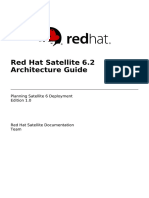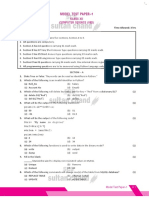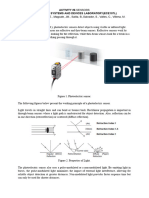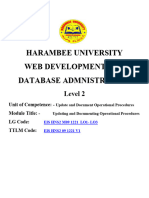VXFS Cheatsheet
Uploaded by
DecemberVXFS Cheatsheet
Uploaded by
DecemberVERITAS Enterprise Consulting Services - Foundation Suite Cheat Sheet
VERITAS File System Commands
File System Operations
Task
Create a VERITAS file system Of a particular size With largefiles Specific block size Mount a VERITAS file system Unmount a file system View file system information Display file system type Resize a file system Enable largefiles Check a file system Do a full check
Command
mkfs F vxfs special_device mkfs F vxfs special_device size mkfs F vxfs o largefiles special_device mkfs F vxfs o bsize=blocksize special_device mount F vxfs special_device mount_point umount special_device | mount_point mount v fstyp v special_device /usr/lib/fs/vxfs/fsadm -b newsize mount_point fsadm F vxfs o largefiles mount_point fsck F vxfs special_device fsck F vxfs o full y special_device
Example
mkfs F vxfs /dev/vx/rdsk/mydg/myvol mkfs F vxfs /dev/vx/rdsk/mydg/myvol 1g mkfs F vxfs o largefiles /dev/vx/rdsk/mydg/myvol mkfs F vxfs o bsize=8192 /dev/vx/rdsk/mydg/myvol Mount F vxfs /dev/vx/dsk/mydg/myvol /mydir umount /mydir umount /dev/vx/dsk/mydg/myvol
fstyp v /dev/vx/dsk/mydg/myvol /usr/lib/fs/vxfs/fsadm -b 512000 /mydir fsadm F vxfs o largefiles /mydir fsck F vxfs /dev/vx/rdsk/mydg/myvol fsck F vxfs o full y /dev/vx/dsk/mydg/myvol
VERITAS Volume Manager Commands
Disk Operations
Task
Initialise a disk vxdiskadm vxdiskadd c#t#d# vxdisksetup i c#t#d# List disks vxdisk list vxdisk list c#t#d# Scanning for new disks Remove a disk vxdiskconfig vxdg [-g diskgroup] rmdisk diskname vxdisk rm c#t#d# vxdg g mydg rmdisk disk02 vxdisk rm c2t2d0 vxdiskadd c2t2d0 vxdisksetup i c2t2d0 vxdisk list vxdisk list c2t2d0
Command
Example
DMP Operations
Task
Display pathing vxdisk list c#t#d# vxdmpadm getdmpnode nodename=c#t#d#s# vxdmpadm getsubpaths dmpnodename= c#t#d#s# Display controllers vxdmpadm listctlr all vxdmpadm listctlr ctlr=c# vxdmpadm getsubpaths ctlr=c# Disable a controller Enable a controller Display enclosures vxdmpadm disable ctlr=c# vxdmpadm enable ctlr=c# vxdmpadm listenclosure all vxdmpadm listenclosure enc# vxdmpadm listenclosure enc1 vxdmpadm listctlr=c2 vxdmpadm getsubpaths ctlr=c2 vxdmpadm disable ctlr=c3 vxdmpadm disable ctlr=c3
Command
vxdisk list c1t1d0
Example
vxdmpadm getdmpnode nodename=c3t2d1s2 vxdmpadm getsubpaths dmpnodename=c3t2d1s2
Page 1 of 2
VERITAS Enterprise Consulting Services - Foundation Suite Cheat Sheet
Disk Group Operations
Task
Create a disk group List disk groups vxdg list vxdg list diskgroup See free space Add a disk to a disk group Remove a disk from disk group Deport a disk group Import a disk group Rename a disk group vxdg [g diskgroup] free vxdg [-g diskgroup] adddisk diskname vxdg [-g diskgroup] rmdisk diskname vxdg deport diskgroup vxdg import diskgroup vxdg n newdg import diskgroup vxdg n newdg deport diskgroup Destroy a disk group Upgrade a disk group vxdg destroy diskgroup vxdg upgrade diskgroup
Command
vxdg init diskgroup diskname=c#t#d# vxdg list vxdg list mydg vxdg g mydg free
Example
vxdg init mydg disk01=c1t1d0 disk02=c1t1d2
vxdg g mydg adddisk disk02=c1t1d2 vxdg g mydg rmdisk disk02 vxdg deport mydg vxdg import mydg vxdg n yourdg import mydg vxdg n yourdg deport mydg vxdg destroy mydg vxdg upgrade mydg
Volume Operations
Task
Create a Volume
Command
vxassist [-g diskgroup] make volume size vxassist [-g diskgroup] make volume size diskname vxassist [-g diskgroup] make volume size layout=layout diskname where layout can be striped/mirrored/raid5/mirrored-stripe/concatenatedmirror/striped-mirror
Example
vxassist g mydg make myvol 2g vxassist g mydg make myvol 2g disk01 disk02 vxassist g mydg make myvol 2g layout=stripe disk01 disk02 disk03
Resize a volume and file system Resize a volume
vxresize f vxfs volume newsize vxassist [-g diskgroup] growto volume newsize vxassist [-g diskgroup] growby volume length vxassist [-g diskgroup] shrinkto volume newsize vxassist [-g diskgroup] shrinkby volume length
vxresize f vxfs myvol 10g vxassist g mydg growto myvol 5g vxassist g mydg growby myvol 1g vxassist g mydg shrinkto myvol 2g vxassist g mydg shrinkby myvol 1g vxassist g mydg maxsize myvol vxassist g mydg mirror myvol vxassist g mydg remove mirror myvol vxassist g mydg move myvol !disk01 vxassist g mydg relayout myvol layout=stripe vxvol g mydg start myvol vxvol g mydg startall vxrecover g mydg s myvol vxvol g mydg stop myvol vxvol g mydg stopall vxedit g mydg rename myvol yourvol vxassist g mydg remove volume myvol
Find max growth Add a mirror Remove a mirror Move volume to another disk Relayout a volume Start a volume Start all volumes Start a disabled volume Stop a volume Stop all volumes Rename a volume Remove a volume
vxassist [-g diskgroup] maxsize volume vxassist [-g diskgroup] mirror volume vxassist [-g diskgroup] remove mirror volume vxassist [ -g diskgroup] move volume !diskname vxassist [ -g diskgroup] relayout volume layout=layout relayout_options vxvol [-g diskgroup] start volume vxvol [g diskgroup] startall vxrecover [g diskgroup] s volume vxvol [-g diskgroup] stop volume vxvol [g diskgroup] stopall vxedit [-g diskgroup] rename volume newvolume vxassist [g diskgroup] remove volume volume
Page 2 of 2
You might also like
- DRBD-Cookbook: How to create your own cluster solution, without SAN or NAS!From EverandDRBD-Cookbook: How to create your own cluster solution, without SAN or NAS!No ratings yet
- ONTAP 90 SMBCIFS Configuration Express GuideNo ratings yetONTAP 90 SMBCIFS Configuration Express Guide26 pages
- Tips & Tricks For Using LVM Effectively / Intro To VXVM: Renay Gaye Hewlett-PackardNo ratings yetTips & Tricks For Using LVM Effectively / Intro To VXVM: Renay Gaye Hewlett-Packard85 pages
- Unit 8 Block Devices, Raid, and LVM: Welcome ToNo ratings yetUnit 8 Block Devices, Raid, and LVM: Welcome To40 pages
- 8 Linux Parted' Commands To Create, Resize and Rescue Disk PartitionsNo ratings yet8 Linux Parted' Commands To Create, Resize and Rescue Disk Partitions13 pages
- VSE+InfoScale Enterprise Veritas High Availability Architecture in VMware 2019 10No ratings yetVSE+InfoScale Enterprise Veritas High Availability Architecture in VMware 2019 1027 pages
- VXVM - Creating A Mirrored Volume From Two Concatinated PlexesNo ratings yetVXVM - Creating A Mirrored Volume From Two Concatinated Plexes5 pages
- How To Install and Configure FreeIPA On CentOS 7 ServerNo ratings yetHow To Install and Configure FreeIPA On CentOS 7 Server15 pages
- L.V.M (Logical Volume Manager) : Create LVM Enable PartitionsNo ratings yetL.V.M (Logical Volume Manager) : Create LVM Enable Partitions6 pages
- Compellent Storage Center Linux Best PracticesNo ratings yetCompellent Storage Center Linux Best Practices45 pages
- SUSE Linux Enterprise: 10 SP1 The Linux Audit FrameworkNo ratings yetSUSE Linux Enterprise: 10 SP1 The Linux Audit Framework76 pages
- How To Monitor - Etc - Shadow and - Etc - Passwd File For Changes With Auditd - The Geek DiaryNo ratings yetHow To Monitor - Etc - Shadow and - Etc - Passwd File For Changes With Auditd - The Geek Diary4 pages
- Highly Available iSCSI Storage With DRBD and Pacemaker: Florian HaasNo ratings yetHighly Available iSCSI Storage With DRBD and Pacemaker: Florian Haas24 pages
- Protecting Business-Critical Applications in A Vmware Infrastructure 3 Environment Using Veritas™ Cluster Server For Vmware EsxNo ratings yetProtecting Business-Critical Applications in A Vmware Infrastructure 3 Environment Using Veritas™ Cluster Server For Vmware Esx18 pages
- High-Performance Oracle: Proven Methods for Achieving Optimum Performance and AvailabilityFrom EverandHigh-Performance Oracle: Proven Methods for Achieving Optimum Performance and AvailabilityNo ratings yet
- Survey On NoSQL Database ClassificationNo ratings yetSurvey On NoSQL Database Classification24 pages
- Unit 10. System Storage Overview: What This Unit Is AboutNo ratings yetUnit 10. System Storage Overview: What This Unit Is About49 pages
- Computer Science-Xii-Model Test Paper-1No ratings yetComputer Science-Xii-Model Test Paper-110 pages
- Best Practices For Survey Research ReportsNo ratings yetBest Practices For Survey Research Reports6 pages
- M07-Recording Client Support RequirementsNo ratings yetM07-Recording Client Support Requirements39 pages
- Update and Document Operational Procedures LO2-LO3 FOR WDDBANo ratings yetUpdate and Document Operational Procedures LO2-LO3 FOR WDDBA7 pages
- Team Evega 2.0-Design Report: I. Improvised Design After The Virtuals RoundNo ratings yetTeam Evega 2.0-Design Report: I. Improvised Design After The Virtuals Round7 pages
- Spare Parts List: Chain Saws 572 XP/XPGNo ratings yetSpare Parts List: Chain Saws 572 XP/XPG42 pages
- Report - Advanced Electronic Voting Machine Using Finger Print ModuleNo ratings yetReport - Advanced Electronic Voting Machine Using Finger Print Module56 pages
- Memo102s2020 - Teach-Back of Microsoft Education Ambassadors and Trainers of Remote Learning On The Use of Microsoft Onenote, Teams & Office 365No ratings yetMemo102s2020 - Teach-Back of Microsoft Education Ambassadors and Trainers of Remote Learning On The Use of Microsoft Onenote, Teams & Office 36510 pages
- Oca Java Se 8 Exam Chapter 2 Operators StatementsNo ratings yetOca Java Se 8 Exam Chapter 2 Operators Statements63 pages
- SAP - Number Range Interval For New Number Range Number100% (3)SAP - Number Range Interval For New Number Range Number2 pages
- Unit-5 Templates and Exception Handling 5.1 Exception HandlingNo ratings yetUnit-5 Templates and Exception Handling 5.1 Exception Handling11 pages
- Ambit 250 and 255 COMPLETE Haxorware Tutorial Step by Step With Pictures100% (1)Ambit 250 and 255 COMPLETE Haxorware Tutorial Step by Step With Pictures9 pages
- SOMATOM - Go - Sim Basic Planning InformationNo ratings yetSOMATOM - Go - Sim Basic Planning Information10 pages






























































































